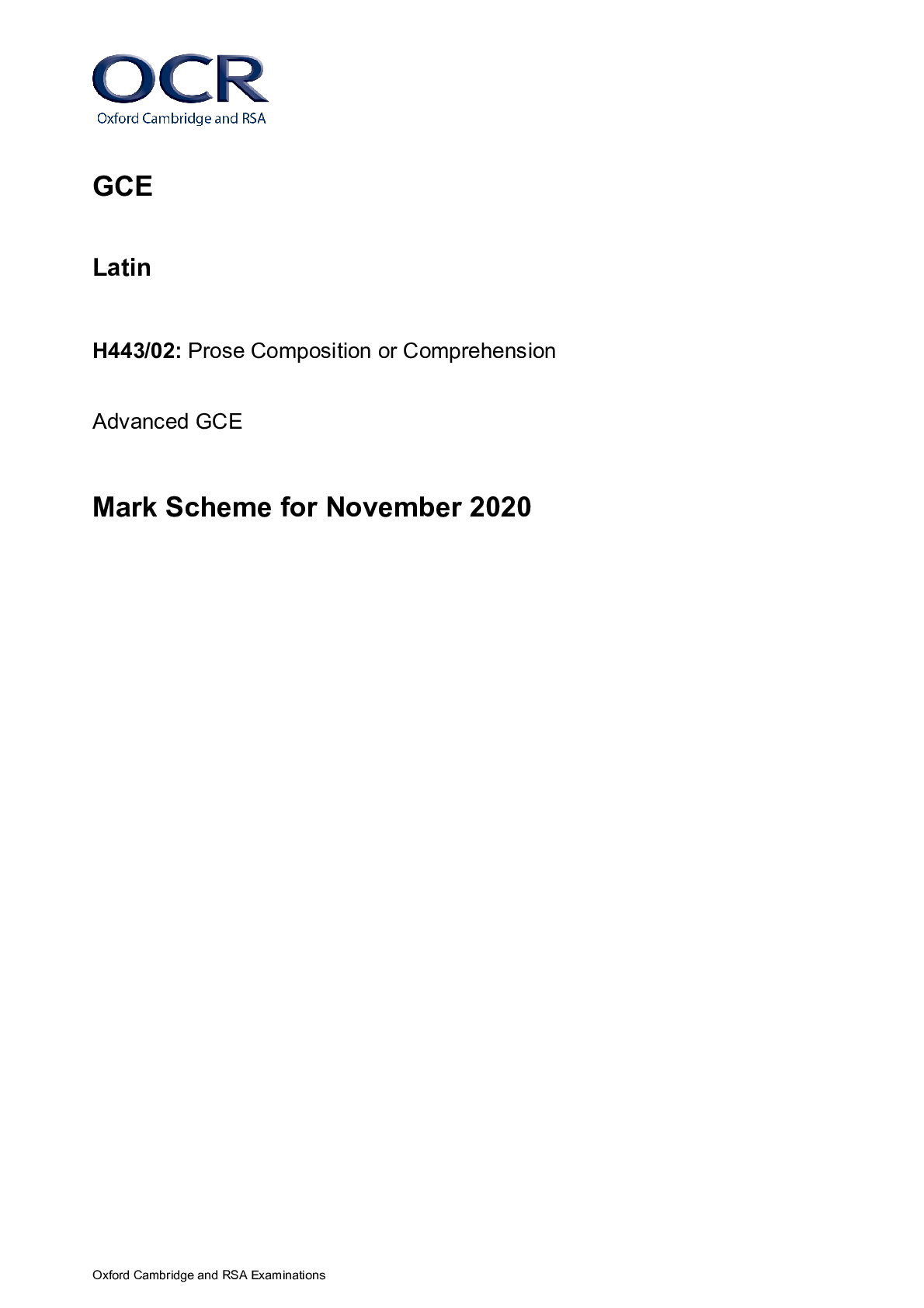Chemistry > GCSE MARK SCHEME > GCE Chemistry A H432/02: Synthesis and analytical techniques Advanced GCE Mark Scheme for November 2 (All)
GCE Chemistry A H432/02: Synthesis and analytical techniques Advanced GCE Mark Scheme for November 2020
Document Content and Description Below
GCE Chemistry A H432/02: Synthesis and analytical techniques Advanced GCE Mark Scheme for November 2020 Oxford Cambridge and RSA Examinations GCE Chemistry A H432/02: Synthesis and analytical tech... niques Advanced GCE Mark Scheme for November 2020Oxford Cambridge and RSA Examinations OCR (Oxford Cambridge and RSA) is a leading UK awarding body, providing a wide range of qualifications to meet the needs of candidates of all ages and abilities. OCR qualifications include AS/A Levels, Diplomas, GCSEs, Cambridge Nationals, Cambridge Technicals, Functional Skills, Key Skills, Entry Level qualifications, NVQs and vocational qualifications in areas such as IT, business, languages, teaching/training, administration and secretarial skills. It is also responsible for developing new specifications to meet national requirements and the needs of students and teachers. OCR is a not-for-profit organisation; any surplus made is invested back into the establishment to help towards the development of qualifications and support, which keep pace with the changing needs of today’s society. This mark scheme is published as an aid to teachers and students, to indicate the requirements of the examination. It shows the basis on which marks were awarded by examiners. It does not indicate the details of the discussions which took place at an examiners’ meeting before marking commenced. All examiners are instructed that alternative correct answers and unexpected approaches in candidates’ scripts must be given marks that fairly reflect the relevant knowledge and skills demonstrated. Mark schemes should be read in conjunction with the published question papers and the report on the examination. © OCR 2020Annotations Annotation Meaning Correct response Incorrect response Omission mark Benefit of doubt given Contradiction Rounding error Error in number of significant figures Error carried forward Level 1 Level 2 Level 3 Benefit of doubt not given Noted but no credit given IgnoreAbbreviations, annotations and conventions used in the detailed Mark Scheme (to include abbreviations and subject-specific conventions). Annotation Meaning DO NOT ALLOW Answers which are not worthy of credit IGNORE Statements which are irrelevant ALLOW Answers that can be accepted ( ) Words which are not essential to gain credit __ Underlined words must be present in answer to score a mark ECF Error carried forward AW Alternative wording ORA Or reverse argumentH432/02 Mark Scheme November 2020 6 SECTION A Question Answer Marks AO element Guidance 1 A 1 1.2 2 B 1 1.1 3 A 1 1.1 4 C 1 2.3 5 D 1 1.2 6 D 1 2.1 7 A 1 1.1 8 C 1 2.2 9 D 1 1.2 10 C 1 2.5 ALLOW 5 11 A 1 2.6 12 A 1 2.2 13 A 1 1.1 14 B 1 2.3 15 C 1 1.2H432/02 Mark Scheme November 2020 SECTION B Question Answer Marks AO element Guidance 16 (a) (i) 2-bromo-3,3-dimethylbutane 1 1.2 IGNORE lack of hyphens or addition of commas ALLOW 3,3-dimethyl-2-bromobutane DO NOT ALLOW 2-bromo-3-dimethylbutane 2,2-dimethyl-3-bromobutane methy for methyl methly for methyl brom for bromo (b) (i) Stereoisomers Same structural formula AND Different arrangement (of atoms) in space OR different spatial arrangement (of atoms) AND Type: Optical 1 1.2 ALLOW structure/displayed/skeletal formula DO NOT ALLOW same empirical formula OR same general formula IGNORE same molecular formula IGNORE references to chiral molecules/compounds (ii) One 3D structure with correct groups attached to the chiral C Two 3D structures of (CH3)3CCHBrCH3 that are mirror images AND correct connectivity in both Br C (CH3)3C HCH3 Br C H3CH C(CH3)3 2 2.5 1.2 ALLOW small slip in one of the groups OR use of C4H9 3D structures must have four central bonds with at least two wedges. For bond into paper accept: ALLOW two 3D structures with 2 groups swapped e.g.H432/02 Mark Scheme November 2020 8 Question Answer Marks AO element Guidance Br C (CH3)3C H CH3 Br C H3C H C(CH3)3 (c) Initiation Br2 → 2Br• Propagation + Br• + HBr 3 1.2 2.5×2 ALLOW Br2 → Br• + Br• IGNORE dots for initiation step, i.e. ALLOW Br2 → Br + Br OR Br2 → 2Br DOT REQUIRED at correct position on chain. ALLOW 1 mark if both propagation equations are correct by atom but dot(s) missing or on incorrect C in chain ALLOW 1 mark if both propagation equations are correct including position of dot(s) but structures are not shown using skeletal formula ALLOW ECF from incorrect intermediateH432/02 Mark Scheme November 2020 9 Question Answer Marks AO element Guidance (d) further substitution/s OR produces different termination products OR More than one termination step OR Mixture of products are formed substitution at different positions along chain 2 1.1×2 ALLOW dibromo/multibromo compounds formed OR an example of a further substitution product OR an example of a different termination product ALLOW more than one hydrogen (atom) can be replaced ALLOW radicals react with each other to form other products IGNORE references to separation of products IGNORE references to atom economy or yield ALLOW a hydrogen (atom) on a different carbon (atom) can be replacedH432/02 Mark Scheme November 2020 10 Question Answer Marks AO element Guidance 17 (a) (i) Organic product with B Organic product with C 2 2.5×2 (ii) Reactivity of B in B electrons are localised OR in B π-bond is localised Reactivity of C in C electrons are delocalised OR In C π-system / ring is delocalised In B, electron density is higher AND B is more susceptible to electrophilic attack OR B attracts/accepts the electrophile/Cl2 more OR B polarises the electrophile/Cl2 more ORA 3 1.1×3 ALLOW labelled diagram to show delocalised system IGNORE charge density IGNORE electronegativity IGNORE B is more reactive/reacts more readily (no reference to electrophile) IGNORE references to electron density spread around the π−ring ALLOW chlorineH432/02 Mark Scheme November 2020 11 Question Answer Marks AO element Guidance (iii) Generation of electrophile AlCl3 + Cl2 → AlCl4– + Cl+ Attack of Cl+ Curly arrow from π-bond to Cl+ -------------------------------------------------------- Intermediate and organic product Correct intermediate Curly arrow from C–H bond to reform π-ring ------------------------------------------------------------- Regeneration of catalyst H+ + AlCl4– → AlCl3 + HCl 5 1.2 1.2 2.5 1.2 1.2 ANNOTATE ANSWER WITH TICKS AND CROSSES ALLOW FeCl3 + Cl2 → FeCl4– + Cl+ ALLOW use of Fe NOTE: curly arrows can be straight, snakelike, etc. ……….. but NOT double-headed or halfheaded arrows 1st curly arrow must • start from, OR close to, circle of benzene ring DO NOT ALLOW following intermediate: π-ring must cover 4 of the 6 sides of the benzene ring AND correct orientation, i.e. gap towards C–Cl ALLOW + sign anywhere inside the ‘hexagon’ of the intermediate.H432/02 Mark Scheme November 2020 12 Question Answer Marks AO element Guidance IGNORE partial charges on the chlorine in the intermediate DO NOT ALLOW mark for intermediate if any CH3 is missing Curly arrow must start from, OR be traced back to, any part of C-H bond and go inside the ‘hexagon’ ALLOW use of AlCl4- in the mechanism ALLOW ECF for regeneration of an incorrect metal chloride catalyst e.g. AgCl3 (b) 3C3H6O → C9H12 + 3H2O molecular formulae of C3H6O AND C9H12 H2O as by-product correct balanced equation 3 2.6 2.5 2.6 (c) (i) Compound C Compound D Number of peaks 3 8 2 3.2H432/02 Mark Scheme November 2020 13 Question Answer Marks AO element Guidance (ii) 5 3.2×5 ALLOW any combination of skeletal OR structural OR displayed formula as long as unambiguous IGNORE names for organic intermediates (question asks for structures ALLOW names of reagents and catalyst Around top arrow, ALLOW 1 of 2 marks if HNO3 and H2SO4 swapped. i.e. IGNORE references to concentration ALLOW (CH3CO)2O for left arrow IGNORE CH3COOH IGNORE acyl chloride DO NOT ALLOW AlCl3/FeCl3/Fe4 H432/02 Mark Scheme November 2020 14 Question Answer Marks AO element Guidance 18 (a) (i) Reagents K2Cr2O7 AND acid AND reflux Equation HO(CH2)4OH + 4[O] → HOOC(CH2)2COOH + 2H2O [O] AND H2O Correctly balanced equation 3 1.1 2.5 2.6 ALLOW Na2Cr2O7 OR Cr2O72– ALLOW H2SO4 OR HCl OR H+ ALLOW words. e.g. ‘acidified dichromate’ ALLOW a small slip in formula for dichromate e.g KCr2O7, (ii) C (CH2)2 C O O HO O H O H H hydrogen/H bond δ+ δ– OR Diagram showing correct dipole charges on each end of one hydrogen bond between a water molecule and a diacid Hydrogen bond between one lone pair on O atom in one of the molecules and the H atom of another AND Hydrogen bonding stated or labelled on diagram 2 2.1×2 ALLOW any combination of skeletal OR structural OR displayed formula as long as unambiguous DO NOT ALLOW δ+ on H atoms of CH2 group ALLOW H-bond for hydrogen bond ALLOW H bond between C=O and H2O, i.e. IF diagram is not labelled, ALLOW hydrogen bond/H bond from textH432/02 Mark Scheme November 2020 15 Question Answer Marks AO element Guidance (b) (i) C (CH2)2 C O (CH2)4 O O O Ester link (must be displayed) Rest of structure 2 1.2 2.5 ALLOW the ‘O’ or C=O at either end, e.g. IGNORE brackets IGNORE n End bonds’ MUST be shown (solid or dotted) DO NOT ALLOW more than one repeat unit (ii) the ester/ ester bond/ ester group /polyester can be broken down OR It can be hydrolysed 1 3.2 IGNORE references to photodegradable ‘Bond breaks’ is not sufficient – no reference to ester bond (iii) SOCl2 in equation Structure of diacyl dichloride Complete balanced equation 3 1.1 1.2 2.6 ALLOW alternative approach using PCl5 or PCl3H432/02 Mark Scheme November 2020 16 Question Answer Marks AO element Guidance 19 (a) (i) (series of organic compounds with the) same functional group OR same/similar chemical properties/reactions each successive/subsequent member differs by CH2 2 1.1 ×2 IGNORE reference to physical properties IGNORE same general formula DO NOT ALLOW same empirical OR molecular formula Differs by CH2 is not sufficient (no successive) (ii) C24H48O 1 2.1 (b) F/aldehyde AND Tollens’ (reagent) AND Silver (mirror/precipitate/ppt/solid) G/alkene/C=C AND Bromine/Br2 AND goes colourless/decolourised G/ketone AND 2,4-dinitrophenylhydrazine AND orange/yellow/red precipitate G/ketone AND Tollens’ (reagent) AND no silver mirror/no change/no reaction 4 2.3 3.3 3.3 3.3 IGNORE use of 2,4-DNP with F ALLOW ammoniacal silver nitrate OR Ag+/NH3 ALLOW black ppt OR grey ppt ALLOW bromine water/ Br2(aq) ALLOW errors in spelling for 2,4-DNP ALLOW 2,4(-)DNP OR 2,4(-)DNPH ALLOW Brady’s reagent or Brady’s Test ALLOW solid OR crystals OR ppt as alternatives for precipitate ALLOW ammoniacal silver nitrate OR Ag+/NH3 ALLOW black ppt OR grey ppt ALLOW alterative approach using acidified potassium dichromate for tests with F and/or G, with correct observations, alongside use of 2,4- DNPH432/02 Mark Scheme November 2020 17 Question Answer Marks AO element Guidance (c) (i) Mechanism 3 marks Curly arrow from –CNto C atom of C=O Dipole shown on C=O bond, Cδ+ and O δ−, AND curly arrow from C=O bond to O atom Curly arrow from lone pair OR – charge on O– of correct intermediate to H+ ----------------------------------------------------------- Product 1 mark -------------------------------------------------------- Name of mechanism 1 mark Nucleophilic addition 5 1.2 1.2 2.5 2.5 1.1 ANNOTATE ANSWER WITH TICKS AND CROSSES Curly arrow must come from lone pair on C of –CN OR CN– OR from minus sign on C of –CN ion (then lone pair on CN– does not need to be shown) Curly arrow from C=O bond must start from, OR be traced back to, any part of C=O bond and go to O -------------------------------------------------------- ALLOW curly arrow to H atom of H2O, i.e. IGNORE attempt to draw curly arrow showing breaking of H–O in H2O IGNORE lack of dipole on H2OH432/02 Mark Scheme November 2020 18 Question Answer Marks AO element Guidance (ii) Heterolytic One (bonded) atom/O receives both/2 electrons Fission Breaking of a covalent bond 2 1.2 ALLOW 2 electrons go to one (bonded) atom/O DO NOT ALLOW both pairs of electrons go to O IGNORE formation of ions/radicals For O atom, ALLOW species DO NOT ALLOW element or molecule ALLOW π bond in C=O breaks IGNORE breaking of C=O bond (no reference to only one bond breaking) ‘Bond breaking’ is not sufficient (no reference to covalent)H432/02 Mark Scheme November 2020 19 Question Answer Marks AO element Guidance 20 (a)* Refer to marking instructions on page 4 of mark scheme for guidance on marking this question. Level 3 (5-6 marks) A correct calculation of the mass of cyclopentanol AND A detailed description of most purification steps There is a well-developed line of reasoning which is clear and logically structured. The information presented is relevant and substantiated. Level 2 (3-4 marks) Calculates the mass of cyclopentanol with some errors AND A detailed description of some purification steps OR A correct calculation of the mass of cyclopentanol AND A detailed description of a few purification steps There is a line of reasoning presented with some structure. The information presented is relevant and supported by some evidence. Level 1 (1-2 marks) Calculates the mass of cyclopentanol with some errors OR A detailed description of some purification steps There is an attempt at a logical structure with a line of reasoning. The information is in the most part relevant. 0 marks No response or no response worthy of credit. 6 2.8×2 3.3×4 Indicative scientific points may include: Calculation of mass of cyclopentanol Using moles • n(cyclopentene) = 4.00 68 = 0.0588…. (mol) • n(cyclopentanol) = 0.0588 × 100 64 = 0.0919…(mol) • Mass of cyclopentanol = 86 × 0.0919 = 7.90 g Using mass • Theoretical mass cyclopentene= 4.00 × 100 64 = 6.25 g • Theoretical n(cyclopentanol) = 6.25 68 = 0.0919 (mol) • Mass of cyclopentanol = 86 × 0.0919 = 7.90 g ALLOW for small slip in Mr / rounding errors Examples of some calculation errors Incorrect inverse ratio: • 0.0588 × 64 100 = 0.0376…. (mol) • Mass = 86 × 0.0376 = 3.24 g Ignoring % yield gives: • 4.00 68 = 0.0588…. (mol) • Mass = 86 × 0.0588 = 5.06 g Purification • Add a neutralising agent by formula or name e.g. Na2CO3 • In separating funnel, organic layer is on top • Drying with an anhydrous salt by formula or name, e.g. MgSO4, Na2SO4, CaCl2 • Redistil at approx. 44ºC Examples of detail in bold (NOT INCLUSIVE)H432/02 Mark Scheme November 2020 20 Question Answer Marks AO element Guidance (b) C=C/alkene peak in region 1620-1680 cm–1 O–H/alcohol peak in region 3200-3600 cm–1 2 3.2×2 LOOK ON THE SPECTRUM for labelled peaks which can be given credit IGNORE references to C-O at 1000cm-1H432/02 Mark Scheme November 2020 21 Question Answer Marks AO element Guidance 21 (a) 5 2.5×5 ALLOW any combination of skeletal OR structural OR displayed formula as long as unambiguous ALLOW HBr ALLOW for the bottom left structure H432/02 Mark Scheme November 2020 22 Question Answer Marks AO element Guidance (b) (i) Ester Amide Amine Carboxylic acid 4 groups correct 3 groups correct 2 groups correct 3 1.2×3 IGNORE amino acid ALLOW carboxyl IGNORE attempt to classify amide, e.g. secondary IGNORE formulae (question asks for names) IF > 4 functional groups are shown, • Count 4 groups max but incorrect groups first IGNORE aryl OR alkyl group e.g. benzene, phenyl, aryl, arene, methyl (ii) Methanol 1 mark Amino Acids 3 marks Both amino acids shown with NH3+ 4 2.5×4 ALLOW any combination of skeletal OR structural OR displayed formula as long as unambiguous ALLOW + charge on H of NH3 group, i.e.NH3+ If BOTH amino acids are shown with NH3 groups (without the + charge) OR as NH2+groups, award 2 of the 3 marks for the amino acids If BOTH amino acids are shown as correctly balanced salts, e.g NH3Cl, all marks can be awarded.H432/02 Mark Scheme November 2020 23 Question Answer Marks AO element Guidance (iii) FIRST CHECK ANSWER ON THE ANSWER LINE If answer = 22.4 OR 22 OR 23 award 3 marks n(aspartame) in 1 can = 0.167 / 294 = 5.68 x 10-4 (mol) n(aspartame) limit per day = 1.7x10-4 x 75 = 0.01275 (mol) number of cans = 0.01275 / 5.68 x 10-4 = 22.4 3 2.2×3 If there is an alternative answer, apply ECF and look for alternative methods Alternative methods n(aspartame) in 1 can = 0.167 / 294 = 5.68 x 10-4 (mol) n(aspartame) per kg = 5.68 x 10-4 / 75 = 7.57 x 10-6 (mol) number of cans = 1.7 x 10-4 / 7.57 x 10-6 = 22.4 OR n(aspartame) limit per day = 1.7x10-4 x 75 =0.01275 (mol) mass(aspartame) limit per day =0.01275 x 294 = 3.7485 (g) number of cans = 3.7485 / 0.167 = 22.4 H432/02 Mark Scheme November 2020 24 Question Answer Marks AO element Guidance 22 (a) CDCl3 used as a solvent D2O used to identify OH OR NH protons 2 1.1×2 Example and use required for each mark ALLOW for 1 mark, D2O as a solvent (b)* Please refer to the marking instructions on page 4 of this mark scheme for guidance on how to mark this question. Level 3 (5–6 marks) Structure I has a viable chemical structure of C6H9NO2 which has the key features consistent with spectral data AND Most of the data analysed There is a well-developed line of reasoning which is clear and logically structured. The information presented is relevant and substantiated. Level 2 (3–4 marks) Compound I has a viable chemical structure of C6H9NO2 with most of the key features consistent with spectral data AND Some of the spectral data analysed. There is a line of reasoning presented with some structure. The information presented is relevant and supported by some evidence. Level 1 (1–2 marks) Correct determination of empirical formula and/or molecular formula. OR Analyses some of the IR and NMR data. OR Analyses most of the NMR data. 6 3.1× 4 3.2× 2 Indicative scientific points: Empirical and Molecular Formulae C : H : N : O = 56.69 12.0 : 7.09 1.0 : 11.02 14.0 : 25.20 16.0 OR 4.72 : 7.09 : 0.787 : 1.575 = 6 : 9 : 1 : 2 • Empirical formula = C6H9NO2 • m/z = 127.0 and empirical formula mass (127) used to determine molecular formula as C6H9NO2 Structures of compound I OR OR OR ALLOW any combination of skeletal OR structural OR displayed formula as long as unambiguousH432/02 Mark Scheme November 2020 25 Question Answer Marks AO element Guidance There is an attempt at a logical structure with a line of reasoning. The information is in the most part relevant. 0 marks No response or no response worthy of credit. Key features • C ≡N • C=O in aldehyde, ketone, ester, amide, acid anhydride • CH3 group that would give a doublet • CH3 group that would give a triplet • CH2 group that would give a quartet 1H NMR and IR analysis 1H NMR spectrum • δ = 4.2 ppm, quartet, 2H CH3– CH2–O • δ = 2.9 ppm, quartet, 1H CO–CH– CH3 • δ = 1.7 ppm, doublet, 3H CO–CH– CH3 • δ = 1.3 ppm, triplet, 3H CH3–CH2 IR spectrum • peak at 1750 (cm–1) is C=O • peak at 2280 (cm–1) is C ≡N ALLOW ranges from Data Sheet IGNORE references to C–O peaksOCR (Oxford Cambridge and RSA Examinations) The Triangle Building Shaftesbury Road Cambridge CB2 8EA OCR Customer Contact Centre Education and Learning Telephone: 01223 553998 Facsimile: 01223 552627 Email: general.qualifications@ocr.org.uk [Show More]
Last updated: 2 years ago
Preview 1 out of 25 pages

Buy this document to get the full access instantly
Instant Download Access after purchase
Buy NowInstant download
We Accept:

Reviews( 0 )
$6.00
Can't find what you want? Try our AI powered Search
Document information
Connected school, study & course
About the document
Uploaded On
Oct 07, 2022
Number of pages
25
Written in
Additional information
This document has been written for:
Uploaded
Oct 07, 2022
Downloads
0
Views
71

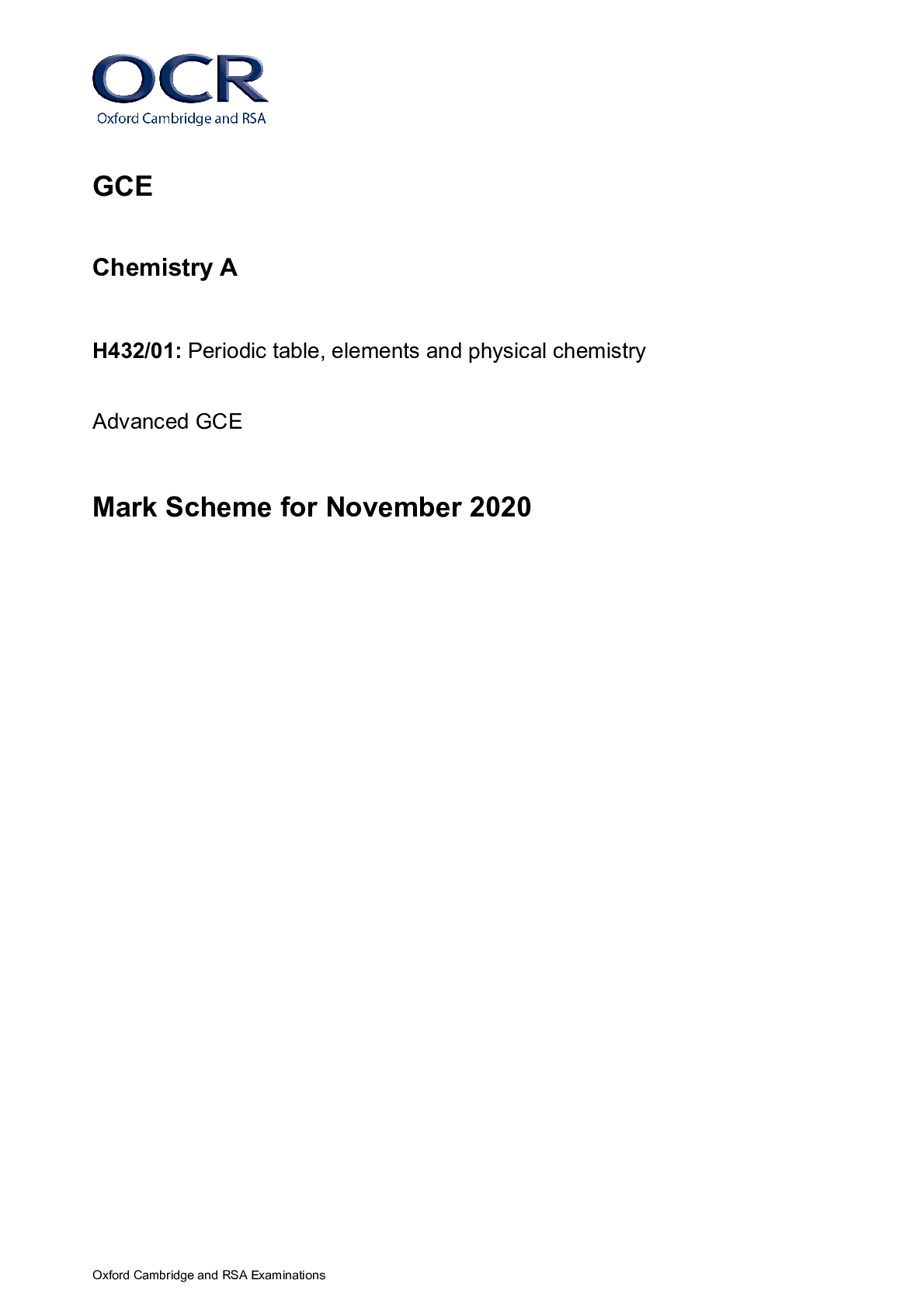
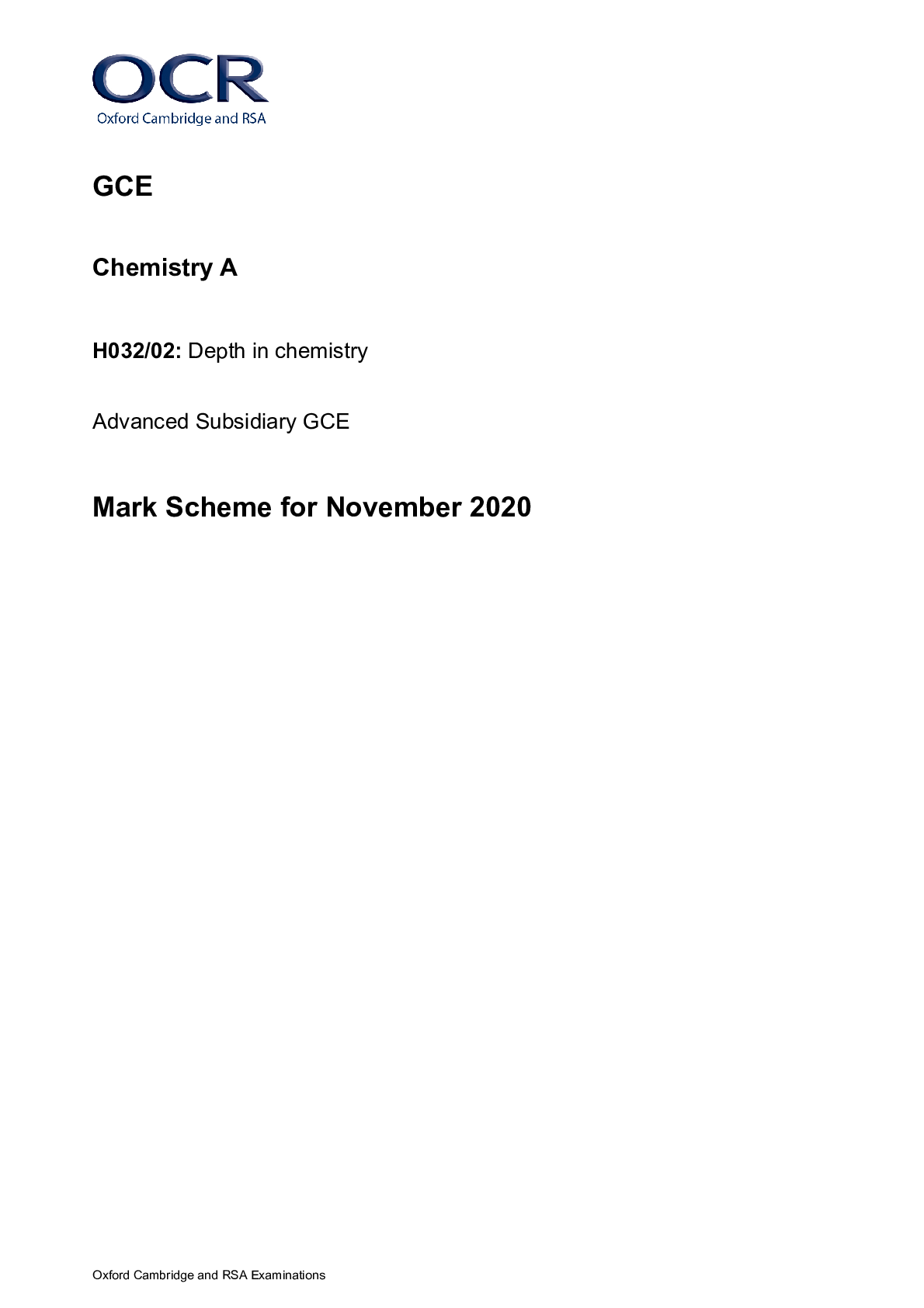

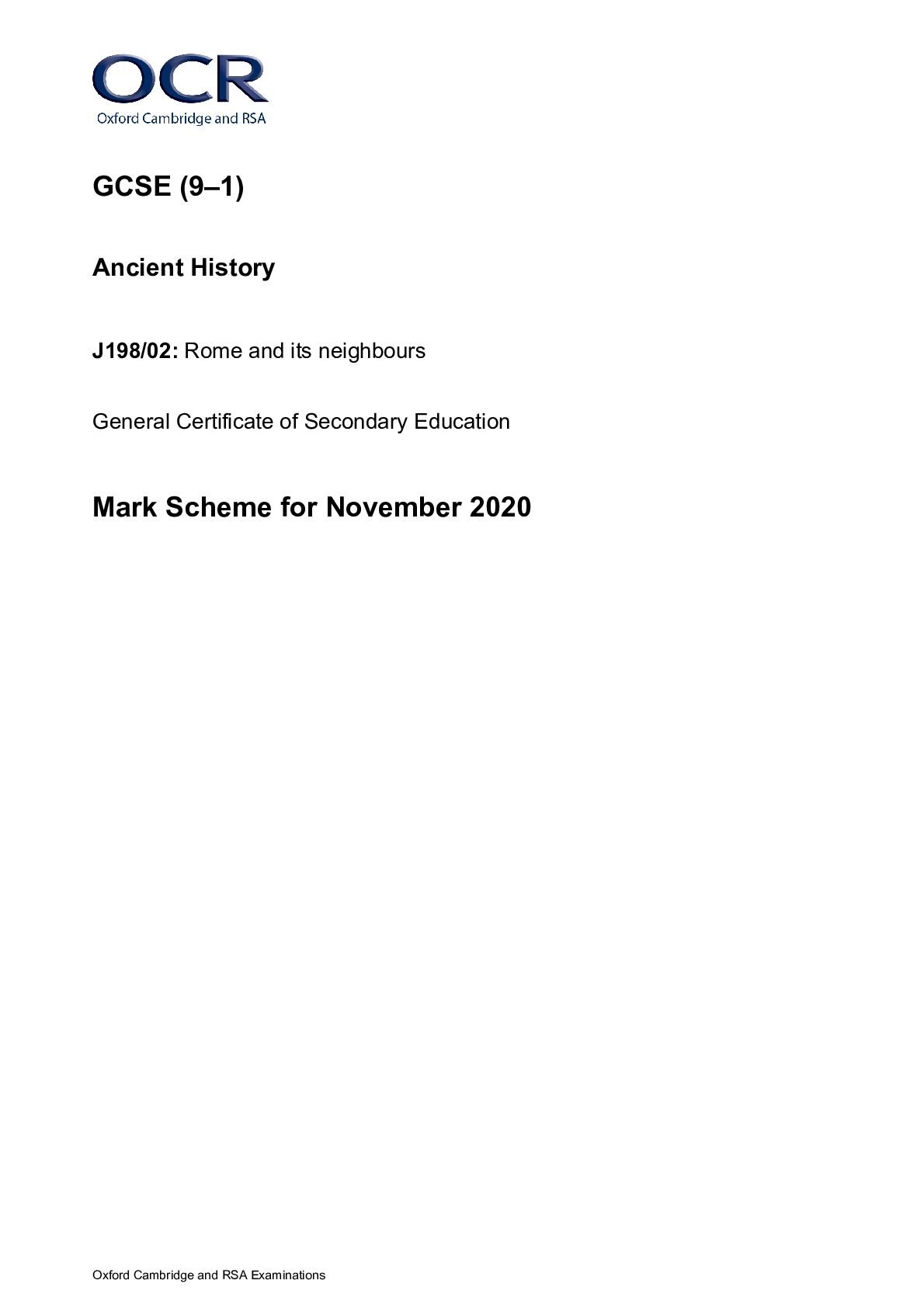




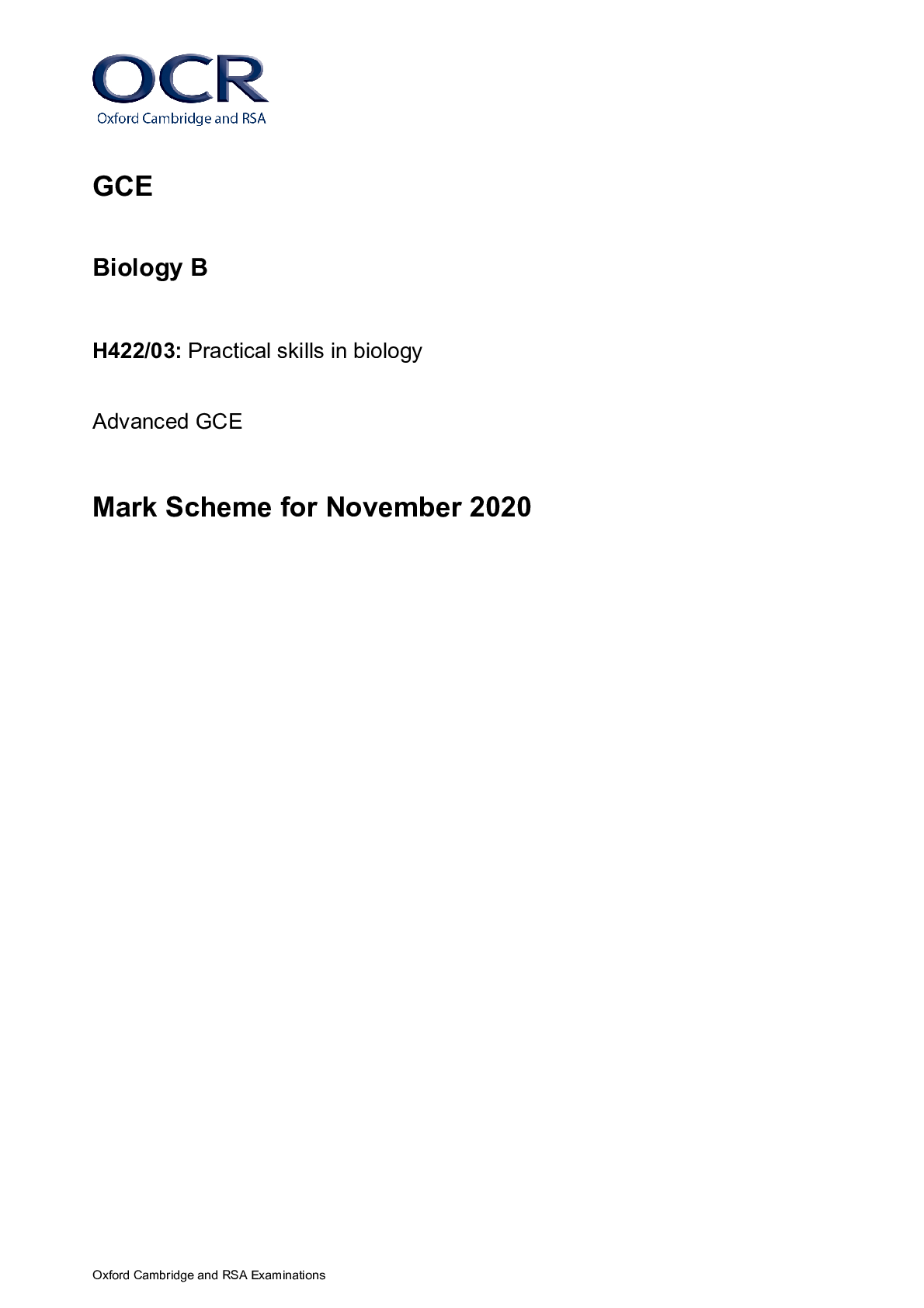
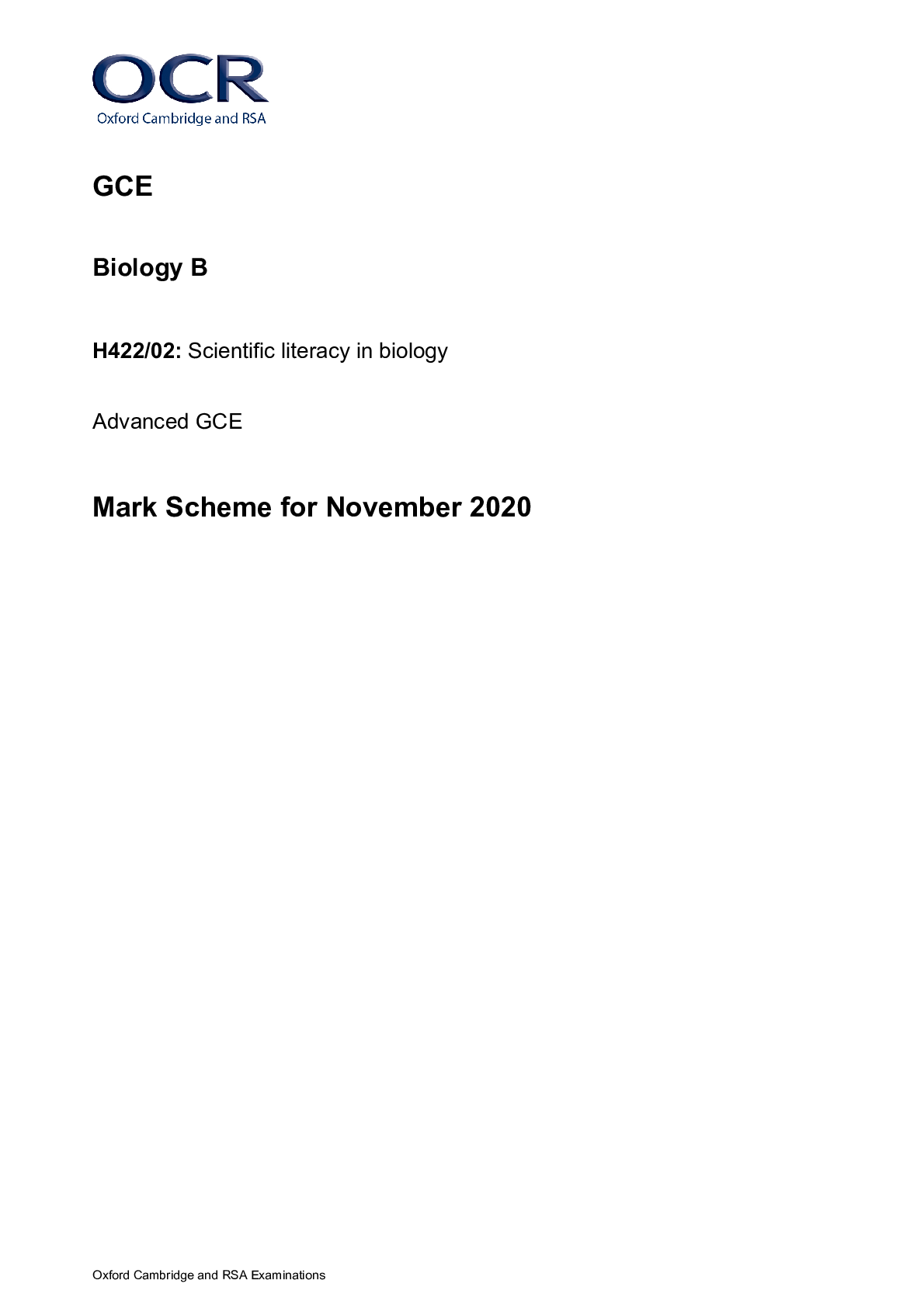
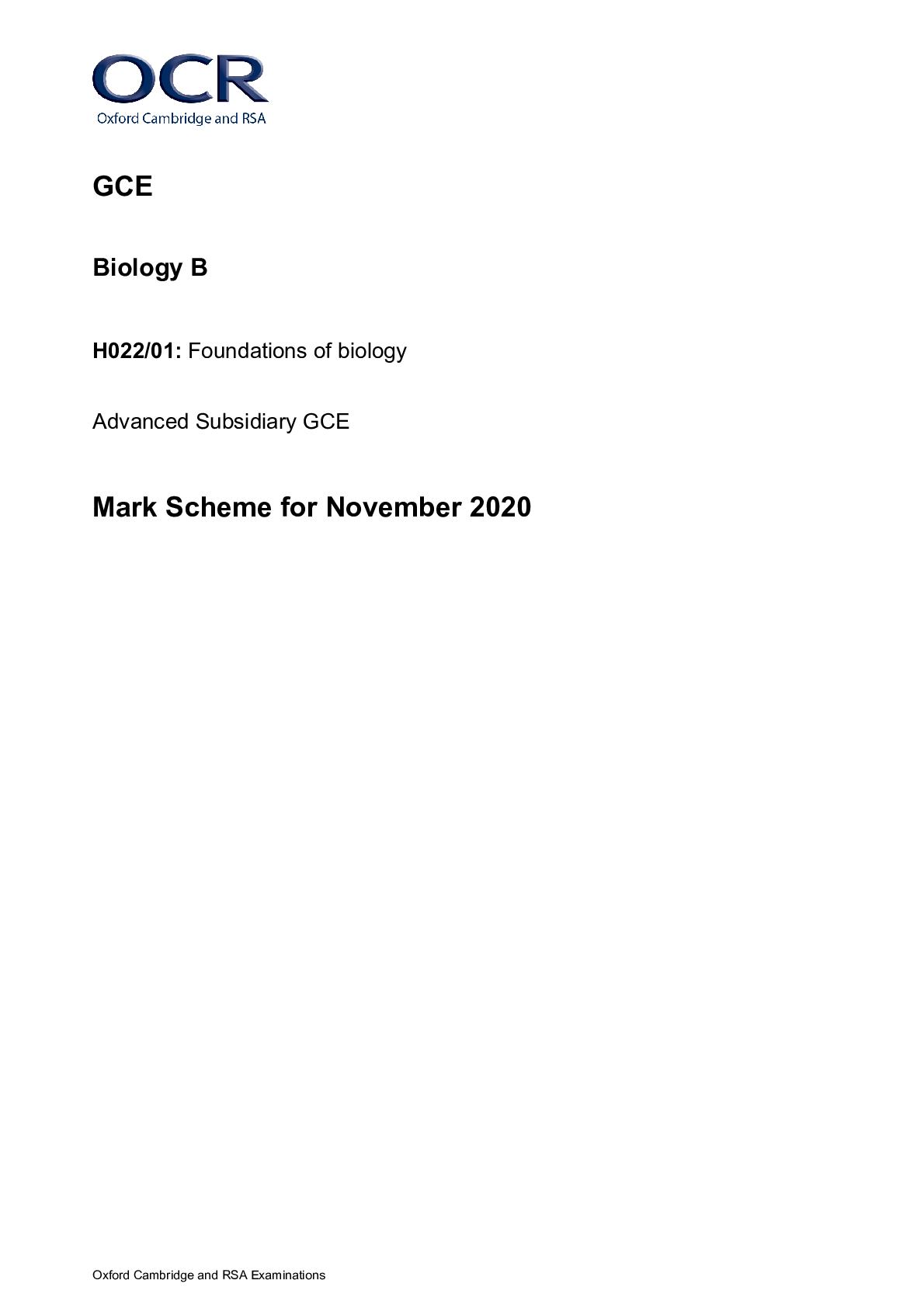



.png)

